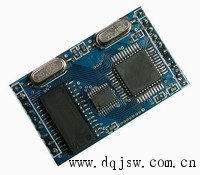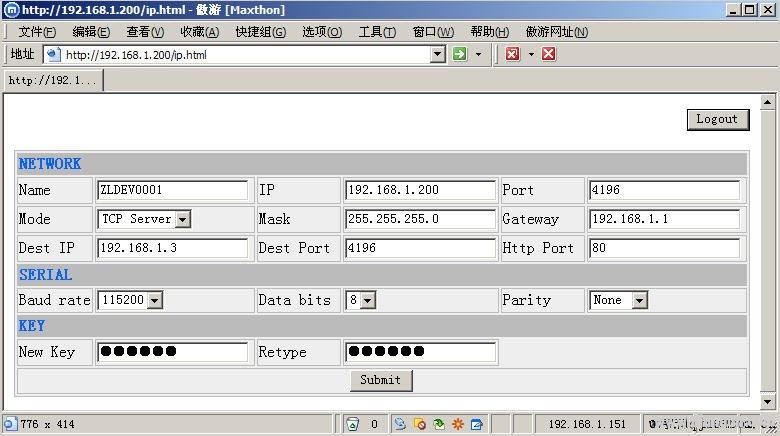1. Introduction to the Serial Server Module
The serial server module is a core hardware component within a serial server, often referred to as an embedded module. All software functions of the serial server are integrated into this core module, meaning that the parameter configuration method follows the same approach as the serial server itself. In certain scenarios, users may want to integrate the serial server's functionality directly into their own circuit board rather than using an external device. In such cases, the embedded serial server module becomes essential. These modules typically support RS232, RS485, and TTL level interfaces. For example, the ZLSN2000 TTL module features a dual-row pin structure, with four pins connected to the network port and two providing a TTL-level serial interface. This can be adapted to RS232 or RS485 levels based on requirements, or it can be directly connected to the user’s MCU for TTL communication.
 Figure 1: Serial Server Core Module
2. Parameters of the Serial Server Module
The key parameters of the serial server module include the local IP address, operating mode, serial port baud rate, and other related settings. Detailed information about these parameters can be found in the documentation provided by the manufacturer.
3. Parameter Configuration Methods
The Zhuoyu serial server embedded module supports three main methods for configuring its parameters: web page configuration, Windows tool configuration, and serial port AT command configuration.
3.1 Web Page Method
The serial server module includes a built-in web server, allowing users to access and configure settings through a browser. This method is similar to configuring a router. To begin, enter the current IP address of the module into the browser’s address bar. The default factory IP is 192.168.1.200. After logging in with the default password (123456), you will be directed to the configuration page. Modify the required settings and click "Submit" to save them.
Figure 1: Serial Server Core Module
2. Parameters of the Serial Server Module
The key parameters of the serial server module include the local IP address, operating mode, serial port baud rate, and other related settings. Detailed information about these parameters can be found in the documentation provided by the manufacturer.
3. Parameter Configuration Methods
The Zhuoyu serial server embedded module supports three main methods for configuring its parameters: web page configuration, Windows tool configuration, and serial port AT command configuration.
3.1 Web Page Method
The serial server module includes a built-in web server, allowing users to access and configure settings through a browser. This method is similar to configuring a router. To begin, enter the current IP address of the module into the browser’s address bar. The default factory IP is 192.168.1.200. After logging in with the default password (123456), you will be directed to the configuration page. Modify the required settings and click "Submit" to save them.
 Figure 2: Web Page Configuration
Advantages of this method include ease of use, no need for additional tools, and direct access via a browser. However, it requires that the computer and the module be on the same network segment. Some advanced settings may still require the Windows tool method.
3.2 Windows Tool Method
This is the recommended configuration method. Users can run software like Zhuo ZLVircom or ZLDevManager on their Windows system. By clicking "Search," the software will locate all serial server modules on the local network. ZLDevManager is a lightweight tool that doesn’t require installation. Select the module from the list, click "Device Edit," and modify the parameters. This method offers several benefits:
- No need for the module and computer to be on the same network.
- Ability to search and manage multiple modules at once.
- Support for advanced configuration options.
The Windows tool method uses the "Zhuo Management Port Protocol" to communicate with the module. Developers can either use the provided DLL library or implement the protocol themselves for integration into custom software.
3.3 Serial Port AT Command Method
This method allows users to configure the module directly through the serial port, without needing an external computer. It is ideal for on-site adjustments, such as setting the IP address or destination IP. Once the user’s MCU is connected via a TTL (UART) serial port, it can send AT commands to the module to modify settings in real-time. This provides flexibility and convenience for field deployments.
Figure 2: Web Page Configuration
Advantages of this method include ease of use, no need for additional tools, and direct access via a browser. However, it requires that the computer and the module be on the same network segment. Some advanced settings may still require the Windows tool method.
3.2 Windows Tool Method
This is the recommended configuration method. Users can run software like Zhuo ZLVircom or ZLDevManager on their Windows system. By clicking "Search," the software will locate all serial server modules on the local network. ZLDevManager is a lightweight tool that doesn’t require installation. Select the module from the list, click "Device Edit," and modify the parameters. This method offers several benefits:
- No need for the module and computer to be on the same network.
- Ability to search and manage multiple modules at once.
- Support for advanced configuration options.
The Windows tool method uses the "Zhuo Management Port Protocol" to communicate with the module. Developers can either use the provided DLL library or implement the protocol themselves for integration into custom software.
3.3 Serial Port AT Command Method
This method allows users to configure the module directly through the serial port, without needing an external computer. It is ideal for on-site adjustments, such as setting the IP address or destination IP. Once the user’s MCU is connected via a TTL (UART) serial port, it can send AT commands to the module to modify settings in real-time. This provides flexibility and convenience for field deployments.
Rocker Switch Panel,Panel Switch,Ranger Switch Panel,Panel Switch Truck
Dongguan Andu Electronic Co., Ltd. , https://www.autoido.com
